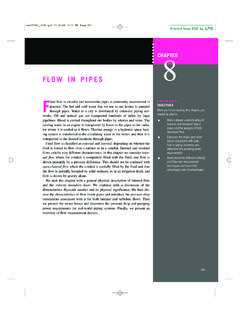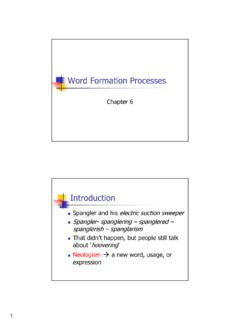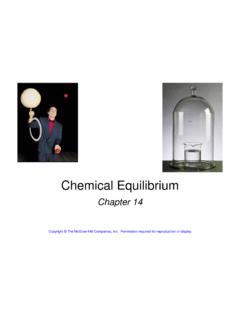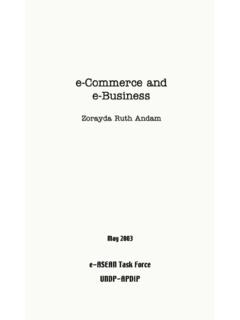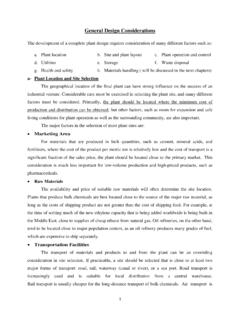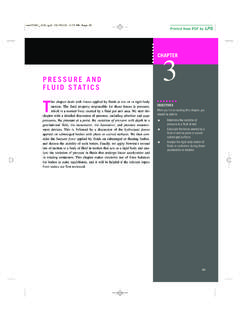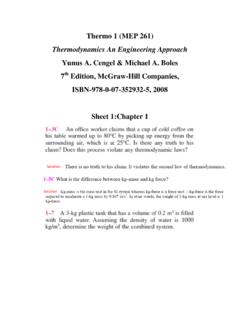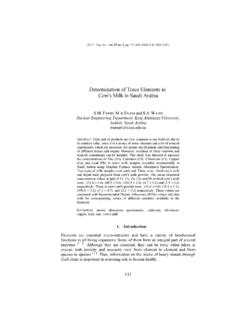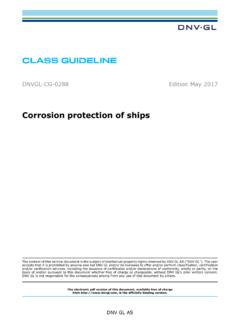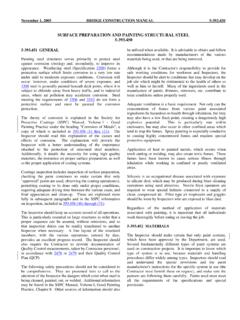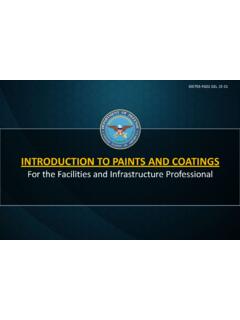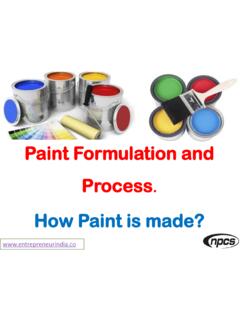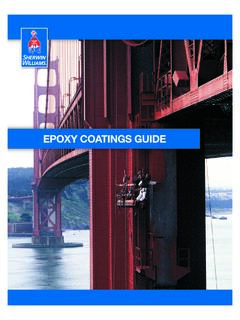Transcription of CORROSION CONTROL Methods of combating corrosion ...
1 1 CORROSION CONTROL Methods of combating CORROSION (protection of metals against CORROSION ) The following Methods are used to protect metals against CORROSION : I. Selection of the right material of construction II. Surface coating. III. Inhibitors IV. Proper equipment design V. Electrical protection I. Selection of the right material of construction The right material of construction should have the following properties: (1) high mechanical strength (2) high CORROSION resistance (3) low cost The following table shows the CORROSION resistance of costructional materials. 2 3 Table 1, CORROSION resistance of constructional materials The material selection is carried out through the following steps 1. Preliminary selection Based on experience, availability and safety aspects 2.
2 Laboratory testing Reevaluation of apparently suitable materials under process conditions 3. Interpretation of laboratory results and other data Effect of possible impurities, excess temperature, excess pressure, agitation, and presence of air in equipment 4. Economic comparison of apparently suitable materials Material and maintenance cost, probable life, cost of product degradation, and liability to special hazards 5. Final selection 4 II. Surface coating There are two types of surface coating: A. Metallic coating The structure is coated with a layer of other metal which may be more noble than the structure or less noble than it steel structures can be coated with copper which is more noble than steel or zinc which is less noble. In case of coating the structure with a more noble metal care should be taken that the coat is free from pores or cracks to avoid the formation of dissimilar metal CORROSION cells which would lead to CORROSION of the structure.
3 Factors that must be considered in selection of a coating metal: 1. The coating should be able to resist direct attack of the environment. 2. The coating should be nonporous and continuous (no cracks) to a void acceleration of CORROSION especially in case of a more noble metal (ex: coating of Fe by Cu). 3. The coating should be hard. In case of coating the structure with a less noble metal the presence of pores and cracks in the coat is not dangerous because in this case the less noble metal will corrode by the formation of dissimilar metal cells while the structure will remain protected. Question: give reasons It is preferred to coat steel with Zn rather than with Cu. In practice metallic coating is carried out by different Methods such: (1) Electroplating, (2) Hot dipping of the work piece in molten metal covered with a flux, (3) Spraying of the molten metal on the work piece.
4 Surface coating Metallic coating Non-metallic coating organic coating inorganic coating 5 (1) Electroplating Electroplating is the method of coating one metal with another. It is most commonly used for decorative purposes, appearance and protection. Electroplated items include chrome bumpers, jewelry, electronics, circuit boards and airplane parts. Electroplating procedure 1. Preparation of the workpiece. Solutions such as alkaline cleaners, solvent degreasers or acidic pickling mixtures are used to remove dirt, greases, oxidation and contaminants from the piece. 2. The piece to be plated is connected to the negative pole (cathode) of the d. c. power supply while the plating (coating) metal anode is connected to the positive pole (anode).
5 Multi-range ammeter (in series) and voltmeter (in parallel) are connected to the cell to measure the cell current and voltage. 3. The piece is then immersed in the plating solution until coated and rinsed and then buffed or polished, if necessary. Note: The plating time depends on the required thickness and can be calculated from Faraday s law. Factors affecting coating quality: The quality of coating depends on: 1. Average thickness of coating 2. Porosity and continuity 3. Uniformity of thickness 4. Adherence 6 Fig. 1, Some examples for electroplating process (2) Hot dipping of the work piece in molten metal covered with a flux There are two common processes of hot dipping: 1. Hot dipping galvanizing It is a hot coating process whereby the cleaned steel is immersed in molten zinc usually at a temperature of between 445 C and 450 C.
6 When the cleaned steel is immersed into the molten zinc, a chemical reaction results, which we refer to as following metallurgical laws . 7 As a result of this process the coating consists of a series of zinc iron alloy layers (inter-metallic layer) and usually a top pure zinc layer. The adhesion of the coating to the steel is therefore determined by means of a chemical bond, or a metallurgical bond . Such bonding is considered to be far superior to that of a mechanical bond. A hot dipped galvanized coating will provide greater CORROSION protection to steel when compared to that of an electroplated product. Fig. 2, Hot dipping galvanizing of steel Fig. 3, Galvanization of steel by hot dipping and electroplating Note: Coating of steel with Zn is called galvanization.
7 It may be carried out by hot dipping or electroplating. 8 2. Hot-dipped tin plating Tinning is the process of thinly coating sheets of iron or steel with tin, and the resulting product is known as tinplate. It is most often used to prevent rust Tinplate made via hot-dipped tin plating is made by cold rolling steel or iron, pickling or remove any scale, annealing to remove any strain hardening, and then coating it with a thin layer of tin. The attached figure shows the tinning process steps. Fig. 4, Basic concept of hot dipped tin plating process Advantage of hot dipping process No waste from production process. No hazardous substance (such as cyanogens, lead, etc.) is used at all in production process. The coating metal and the base metal are strongly bonded as inter-metallic layer formed.
8 Provide greater CORROSION protection to steel when compared to that of an electroplated product. 9 (3) Spraying of the molten metal on the work piece. Thermal spraying refers to a process by which a metal wire or powder is melted and sprayed onto a surface to form a coating. A thermal spray gun is used to apply the coatings. The thermal spray gun heats the metallic wire or powder to a molten state and compressed air or other gas propels it onto the surface to form a coating. The compressed gas also aids in division and atomization of the molten coating. The two metals most commonly applied by thermal spray are zinc and aluminum. These metals and their alloys provide excellent protection in a variety of marine and industrial corrosive environments.
9 Questions: 1. Sketch a simple cell for galvanization of steel one by electroplating and one by hot dipping 2. What are the advantages of hot dipping when compared with electroplating as a method for metallic coating? 3. What are the main factors that should be considered when selecting a coating metal and what are the main factors affecting the coating quality? 4. Explain the main steps involved in electroplating process with the help of simple sketch. 5. Why it is preferred to coat steel with zinc rather than with copper. Non-metallic coating (the second method of surface coating) There are two types of nonmetallic coating: A. Inorganic coating Methods of inorganic coating: i. Oxidation (passivation) Steel can be coated with an oxide film by a). Heating at high temperature, b).
10 Chemical oxidation by treating steel with hot alkaline nitrate, or persulphate or perchlorate c). Anodic oxidation by making the steel structure an anode in electrolytic cell 10 ii. Phosphating Steel is coated with a layer of iron phosphate by dipping in a solution containing phosphoric acid and zinc phosphate. The iron phosphate film is not highly protective because it is porous so it usually covered with paint . The phosphate film improves the bond between the metal and the paint . Phosphating is a pre-painting step. iii. Enamels Enamels are glassy layer applied to the metal by dipping it in a suspension of powdered glass, and then the metal is heated in a stove (furnace) at high temperature where the glass powder melts and coat the metal.
